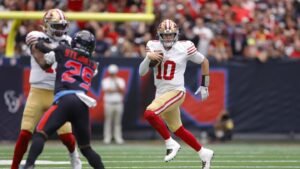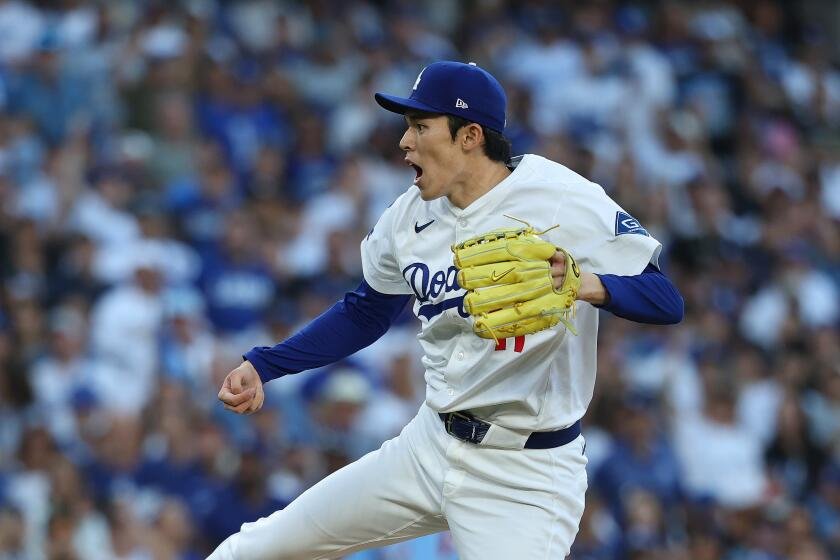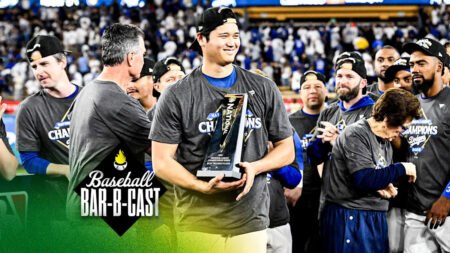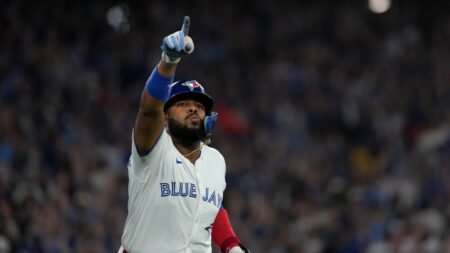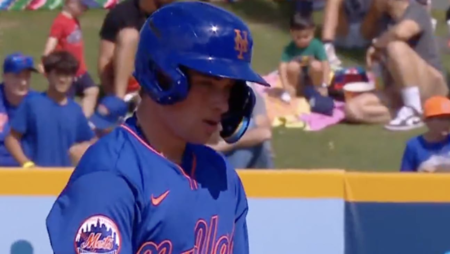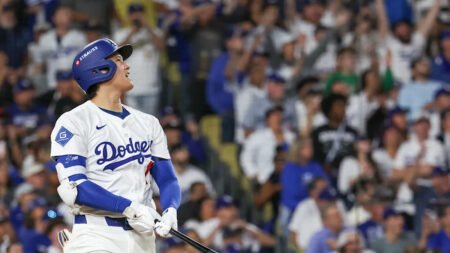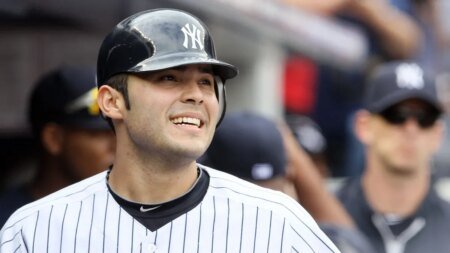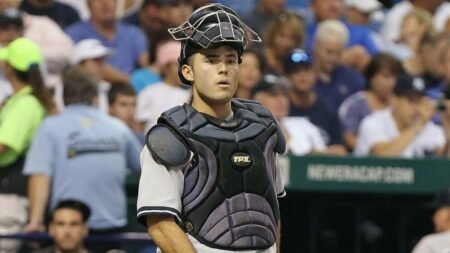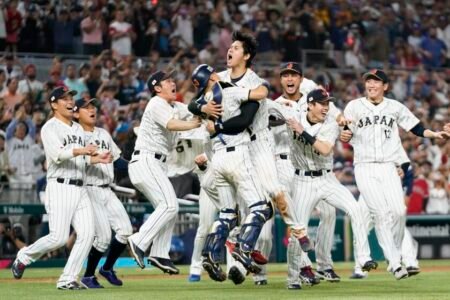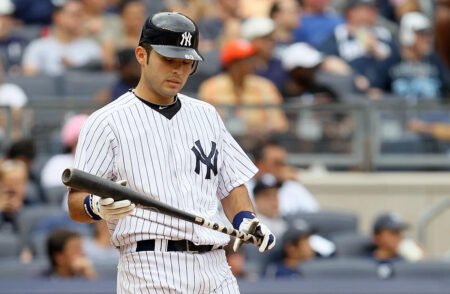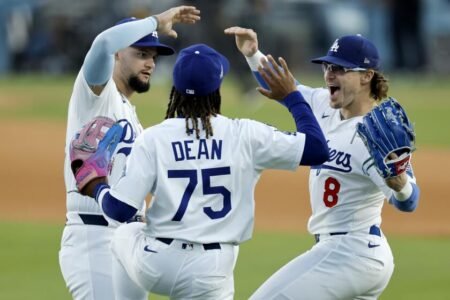Roki Sasaki was literally the toast of the Dodgers.
“Shot for Roki!” infielder Miguel Rojas screamed.
Hooting and hollering, the players raised the little paper cups in their hands and emptied the contents into their mouths to celebrate the three perfect innings delivered by Sasaki in an 11-inning, 2-1 victory over the Philadelphia Phillies that secured their place in the National League Championship Series.
Advertisement
The emergence of Sasaki as an October hero was as unexpected as his relief performances in the NL Division Series were electric.
How did this happen?
How could a newcomer who practically vanished when he went down with a shoulder impingement five months earlier become the team’s most dominant reliever?
How could a pitcher on whom the Dodgers had more or less given up produce what manager Dave Roberts described as “one of the great all-time appearances out of the pen”?
Sasaki can point to when he started down the road to postseason glory.
“The scene in the hotel,” Sasaki said in Japanese.
Sept. 8.
Sasaki was in a hotel room in Oklahoma City, preparing to pitch the next day for the Dodgers’ triple-A affiliate.
Advertisement
Read more: Plaschke: A wild finish propels the Dodgers into NLCS and past their toughest playoff test
While eating, he watched videos of himself pitching for Ofunato High School. His signature high leg kick was the same then as it was now, but what he did in the next phase of his delivery wasn’t.
Sasaki noticed that he used to be more explosive before landing his plant foot and releasing the baseball.
“This is it,” he said to himself.
Right there, in his Oklahoma City hotel room, Sasaki started shadow pitching, wanting to recapture the feeling in his lower body from when he was viewed as the most talented pitcher his country had ever produced.
Advertisement
The next day, Sasaki rediscovered his fastball.
Of the 90 pitches he threw in his 4⅔-inning start, six of them were clocked faster than 100 mph. His average fastball velocity was 98.5 mph.
Dodgers pitcher Roki Sasaki delivers during the eighth inning of Game 4 of the NLDS against the Phillies at Dodger Stadium on Thursday. (Robert Gauthier / Los Angeles Times)
His average fastball velocity in the start before that: 94.4 mph.
A couple of days later, Sasaki met with Dodgers president of baseball operations Andrew Friedman and general manager Brandon Gomes. While assuring him they viewed him as a starter next year and beyond, they presented him with the idea of a temporary move to the bullpen, which could drastically improve his chances of making the playoff roster.
Sasaki has done more than make the roster.
Advertisement
Most valuable players aren’t chosen for division-round series, but if they were, Sasaki would have likely claimed the prize.
He saved Games 1 and 2.
Roberts called on Sasaki to pitch two innings in the clinching game. Sasaki ended up pitching three, starting with an eighth inning in which he retired Kyle Schwarber, Bryce Harper and Alec Bohm in order.
Sasaki made the Phillies look as overmatched at the plate as Postseason Shohei Ohtani, also pitching perfect ninth and 10th innings.
“I was relieved,” Sasaki said.
Roberts was feeling more intense emotion — “Pure elation,” he said — which was why he didn’t wait for Sasaki to return to the dugout to embrace him. Roberts jumped off the bench and hugged Sasaki on the field.
Advertisement
Sasaki’s effort kept the score level at 1-1, positioning the Dodgers to win the game in the 11th inning on a throwing error by Phillies reliever Orion Kerkering.
“Roki was unbelievable,” starter Tyler Glasnow said. “Since coming back, coming in from the bullpen, he’s honestly one of the best pitchers I’ve ever seen. His stuff is incredible.”
Sasaki didn’t look like this in the eight starts he made early in the regular season. Part of that was health-related, as Sasaki has said that his shoulder problems affected his arm slot. When Sasaki recovered, he regained more than his natural throwing motion and previous fastball velocity.
He also regained his confidence.
Advertisement
Sasaki has projected an entirely different energy than he did at his introductory news conference, at which he looked uncomfortable.
When he was asked if he was taunted by fans at Citizens Bank Park, he said he didn’t understand what they were saying. The implication: He didn’t care.
Read more: Dodgers defeat Phillies in a wild, instant-classic walk-off to reach the NLCS
When he was asked about his first season in the major leagues, he said he felt as if his injury prevented him from gauging the level of competition. The implication: If he was healthy, he would have dominated the way he is now.
“He’s very shy, reserved,” Roberts said. “But I do think that [since] coming back, he’s opened up a lot more. I think he’s showing more of who he really is and showing some emotion.”
Advertisement
The change was reflected on the field in the NLDS, Sasaki attacking the Phillies in a style that conveyed a hit-me-if-you-can attitude. The demeanor has contributed to him being the ace of the bullpen this October and it could be why he will be the ace of the rotation in the future.
“We’re starting to see something really special in him,” Roberts said. “What he’s done now on the biggest stages, he’s just scratching the surface.”
Sign up for more Dodgers news with Dodgers Dugout. Delivered at the start of each series.
This story originally appeared in Los Angeles Times.
Read the full article here

